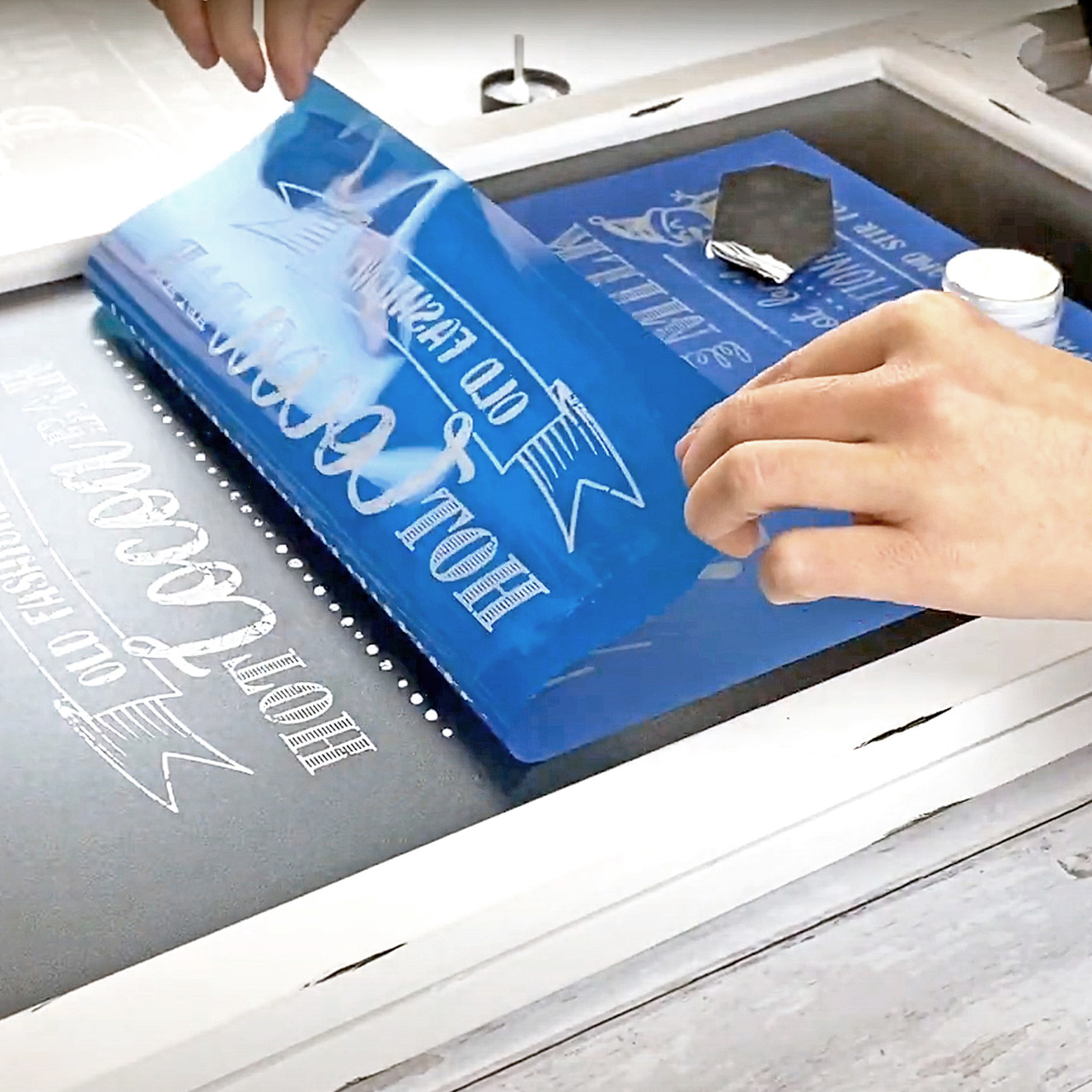High-Volume T-Shirt Printing for Schools and Organizations
Wiki Article
Display Printing Uncovered: Everything You Need to Know About Tee Shirt and Garment Printing Methods
If you have actually ever before asked yourself just how those lively styles wind up on your preferred tees, you're in the best location. Display printing is an interesting approach that combines art with method, using endless possibilities for creative thinking. Comprehending the fundamentals, from devices to ink options, can considerably influence your results. Ready to discover the necessary elements that make display publishing an art form? Let's discover the information that can raise your projects.
The Essentials of Display Printing: Exactly How It Functions
When you plunge right into screen printing, you'll uncover it's both a scientific research and an art. At its core, screen printing entails producing a stencil, or display, that enables ink to travel through only in specific locations (screen printing kit). You start by picking your design and preparing your display with a light-sensitive solution. When you reveal this emulsion to light, it solidifies, leaving your design as an unfavorable room.Following, you'll blend your inks and prepare your printing surface. Position the screen over the material, then utilize a squeegee to press ink through the screen onto the garment. This process needs accuracy, as you desire clear, dynamic prints. After printing, you'll heal the ink with warmth, ensuring it follows the material and lasts with cleans. Each step is essential, and grasping them will boost your display printing skills, changing simple garments into one-of-a-kind, meaningful items.
Types of Display Printing Techniques
Once you grasp the basics of screen printing, it's time to explore the various techniques that can elevate your designs. One popular approach is conventional screen printing, where ink is pushed through a stenciled display. This method is wonderful for vibrant, vivid colors. There's water-based ink printing, which provides a softer feel and is eco-friendly, yet it calls for a different method to curing.If you're going for great details, take into consideration discharge printing. This strategy eliminates dye from the textile, leaving a soft, vintage look. An additional option is plastisol printing, known for its sturdiness and vivid shades, making it a preferred for numerous brand names. Lastly, explore halftone printing to create slope effects and detailed designs. Each strategy has its special charm, so don't be reluctant to attempt them out to discover what fits your style best!
Important Equipment for Screen Printing
To achieve sensational lead to screen printing, having the ideal tools is fundamental. You'll require a durable display printing framework, which holds the mesh that transfers your style onto the garment. Next off, buy top notch squeegees; these are necessary for using ink equally across the display. You'll also require a great direct exposure device to create your screens, in addition to a washout booth for cleaning them after usage. A dependable warm resource, like a conveyor clothes dryer or heat press, is crucial for healing your prints to ensure long life. Don't fail to remember an appropriate work area, geared up with tables and storage space for your materials. Protective equipment, such as masks and handwear covers, will certainly keep you risk-free from chemicals and inks. With the right tools, you'll be well on your means to generating professional-quality prints.Picking the Right Inks and Products
When picking inks and materials for screen printing, you require to take into account the kind of ink that works ideal for your job. Think of material compatibility to guarantee your designs look last and excellent long. Discover environment-friendly ink choices to make your printing process a lot more lasting.Kinds of Screen Inks
Choosing the ideal screen ink is necessary for accomplishing dynamic, durable prints that fulfill your job's requirements. There are several sorts of display inks to examine. Plastisol ink is popular for its adaptability and ease of use, giving outstanding color opacity on dark fabrics. Water-based ink, on the various other hand, provides a softer feeling and is green, making it optimal for those wanting to decrease their ecological impact. Release inks eliminate dye from the textile, leading to a soft, vintage appearance however require specific handling. Ultimately, specialty inks, such as glow-in-the-dark or metal, can add unique results to your layouts. Examine your job requirements and select the ink that lines up ideal with your desired end result.
Material Compatibility Factors To Consider
Recognizing textile compatibility is vital for achieving top notch display prints, specifically since different products react distinctly to different inks. When picking inks, think about the textile type-- cotton, polyester, or blends. For cotton, water-based inks work well, using softness and breathability. Polyester, on the other hand, frequently calls for plastisol inks for far better adhesion and lively colors. You might require to use a mix of both kinds if you're printing on blends. Always evaluate your inks on sample fabric to guarantee they stick properly and preserve shade integrity. Furthermore, bear in mind that fabric weight and appearance can affect the final result, so picking the appropriate ink and material combination is important for your project's success.Eco-Friendly Ink Options
Eco-friendly inks are becoming a popular choice for display printers who want to lessen their ecological impact while keeping top quality. When selecting inks, consider water-based inks, which are less harmful and easier to cleanse up compared to conventional solvents.Furthermore, look for inks made from sustainable resources, such as soy or vegetable-based options. By picking the ideal inks and products, you'll not just produce spectacular layouts but also add to an extra lasting printing procedure. Make the button, and your prints will reflect your dedication to the setting!
Preparing Your Style for Screen Printing

Submit Format Needs
To assure your layout looks sharp and vibrant on textile, you'll require to pay close focus to submit style demands for screen printing. Make sure your design has a transparent background to prevent unwanted white sides on your prints. Maintain shade settings in mind; CMYK is basic for screen printing, so convert your RGB makes appropriately.Shade Splitting Up Techniques
Shade splitting up is a crucial action in preparing your style for display printing, and grasping it can substantially boost your print quality. You'll require to break your design right into specific shades, as each color requires a separate screen during printing. Start by identifying all the colors in your design and develop layers each. You can use software application like Adobe Photoshop or Illustrator to isolate and different colors successfully. Be specific to save each layer as a different data, typically in a format like TIFF or PSD. This accuracy not just guarantees exact shade representation yet likewise streamlines the printing procedure. By taking notice of color separation, you'll achieve vivid and specialist cause your screen-printed garments.Resolution and Size
Attaining the finest lead to screen printing begins with ensuring your design has the right resolution and dimension. Ideally, your artwork should go to the very least 300 DPI (dots per inch) for sharp, clear prints. If you make use of lower resolution, your last item might look pixelated and unprofessional.When it concerns size, take into consideration the dimensions of your print area. Style your art work to match the last print dimension, preferably developing it in the actual dimensions you'll be publishing. In this manner, you'll stay clear of any unforeseen scaling problems.
Always inspect your style in both vector and raster styles. Vector graphics can be scaled without shedding quality, making them suitable for display printing. Preparing correctly will guarantee your design looks remarkable on every garment!
Step-by-Step Screen Printing Process
Screen printing is a dynamic procedure that allows you to develop vivid layouts on different surfaces. To begin, you'll need a display, solution, and your chosen ink. Initially, prepare your display by cleaning it completely. Next off, apply the emulsion equally and let it completely dry in a dark location. Once dry, reveal your screen to light with your layout positioned on it, which will certainly set the solution where the light hits, producing a pattern - screen printing kit.Pour ink onto the display and make use of a squeegee to press the ink via the pattern onto the fabric. Raise the display thoroughly and let the print dry. You've effectively display published your layout.
Tips for Successful Screen Printing Projects
While you're diving right into your display printing tasks, remember that prep work is key to success. Start by gathering all your materials-- inks, squeegees, displays, and garments. A clean office aids protect against undesirable errors, so clean up prior to you begin.Next, confirm your artwork is high-resolution and appropriately sized for your garment. Test your screen for proper direct exposure and clean it extensively to prevent spots. When blending your inks, follow the maker's standards to achieve the ideal uniformity.
Throughout printing, apply even pressure with your squeegee for regular outcomes. Do not rush; take your time to validate each print fulfills your standards. After printing, let your garments completely dry entirely before dealing with or packaging them.
Last but not least, constantly keep a sample of your help future recommendation. This means, you can assess your development and boost your techniques gradually. Happy printing!

Regularly Asked Concerns
For how long Does It Take to Establish up a Screen Printing Job?
Establishing up a screen printing job commonly takes around half an hour to an hour. You'll prepare the displays, mix inks, and adjust the press. The moment differs based upon intricacy and experience, so stay organized!Can I Publish on Various Textile Keys In Making Use Of the Very Same Strategy?
Yes, you can print on different textile kinds utilizing the same strategy, yet you'll require to change your setups and inks. Some materials absorb ink in different ways, so trying out warranties the finest outcomes for each material.What Are Usual Blunders to Stay Clear Of in Display Printing?
When display printing, prevent t-shirt printing usual mistakes like making use of the wrong ink, disregarding correct exposure times, or skipping pre-press checks. Always evaluate your setup and keep tidy screens to guarantee top quality results each time.Just How Can I Correctly Tidy and Maintain My Display Printing Equipment?
To appropriately tidy and maintain your screen printing equipment, you need to consistently wash displays with appropriate solvents, inspect mops for wear, and guarantee all devices are stored dust-free and completely dry. Uniformity improves and protects against expensive repair work efficiency.Is Screen Printing Eco-friendly Contrasted to Other Approaches?
Screen printing can be extra eco-friendly than various other methods, specifically if you utilize eco-conscious products and water-based inks. By choosing lasting materials and practices, you decrease waste and decrease your influence on the planet.Display Printing Uncovered: Whatever You Required to Know About Tee Shirt and Garment Printing Strategies
At its core, screen printing includes producing a pattern, or screen, that enables ink to pass via only in details areas. Placement the display over the fabric, then use a squeegee to press ink via the screen onto the garment. One prominent technique is typical display printing, where ink is pressed via a stenciled display.When choosing inks and materials for display printing, you need to take right into account the kind of ink that functions ideal for your task.
Report this wiki page